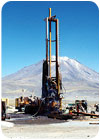
High in the mountains of Ojos De San Pedro, Chile, there are five volcanoes that have shaped the landscape of the area for centuries. Through years of activity, these volcanoes have created ground formations of volcanic rock and basalt that have combined with the already difficult mountainous terrain.
A recent drilling project in this region required drilling contractor Ingeneria Captagua to install seven water wells to provide sufficient water supply for the mine of Chuquicamata to a maximum depth of 818 feet. The drilling conditions were extremely difficult with an altitude of 14,000 feet and temperatures ranging between 32 degrees F and 50 degrees F. An additional complication was that it was required that each well be drilled down to 818 feet, no matter how much water was encountered at the top of the hole. Relying on its experience in the area, Ingeneria Captagua knew traditional drilling methods would not work in this environment, and it needed to find the right drilling technology to conquer this task. The company turned to its Chilean drilling products distributor, Thiessen SA, to help provide the right tools.
Thiessen SA recommended using the Challenger 125 hammer (N125), manufactured by NUMA, as it provides the appropriate range for the various bit sizes to be used. The installation of this water well required that a series of holes be drilled by telescopic method ranging from 23 inches to 17 inches in diameter to a final depth of more than 800 feet. Much of this drilling was conducted in volcanic rock and basalt, and also against water in the hole. Static water was found 60 feet down and remained throughout the drilling. The wells were measured to produce over 3,600 gallons per minute of water. Baroid drilling foam was used to help get the water and drill cuttings out of the hole.
A key factor for this project was that the drilling had to be done at an extremely high altitude. High altitude and high temperatures have a direct effect on the molecular structure of air. These factors must be kept in mind when analyzing how much air a hammer will need for a job. An adjustment in cfm must be made to accommodate such changes to provide for fast and efficient drilling. At high altitudes, there are fewer molecules in a given volume of air than at lower altitudes. Therefore, when a compressor displaces a given volume at high altitudes, the air will be less dense and require more volume than at sea level.
In the mountains of Ojos De San Pedro, Ingeneria Captagua drilled at 14,000 feet above sea level with an average temperature of approximately 40 degrees F. At sea level, the Challenger 125 hammer requires only 1,800 cfm at 200 psi. By using a correction factor chart, the drilling contractor was able to calculate a need of 2,850 cfm. When drilling began with the Foremost DR24 rig, Ingeneria Captagua had linked together the rig’s Sullair 950/350 compressor with two Atlas Copco 950/350 compressors to provide the correct volume of air. If they had used only the standard requirement of 1,800 cfm, and not used a cfm-correction-factor chart, the actual air volume would have been only 1,102 cfm, which would not have been enough to properly operate the hammer and lift the cuttings out of the hole.
The DTH products performed without flaw in the hard formations, high altitude and varied temperatures to successfully install the seven wells with no down time due to product failure. To attain these results, the most critical factor was calculating the CFM required by Ingeneria Captagua’s drilling environment to ensure that the hammer performed to its standards.
ND
Report Abusive Comment